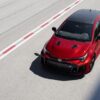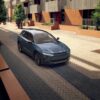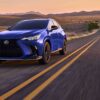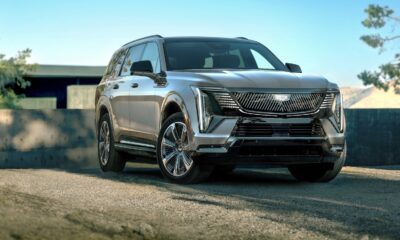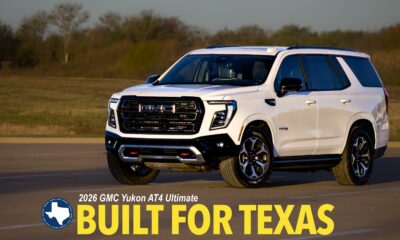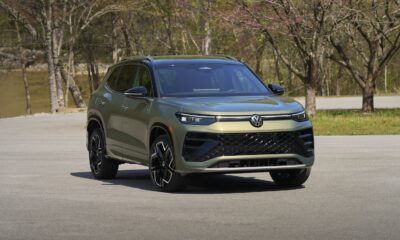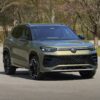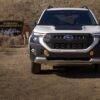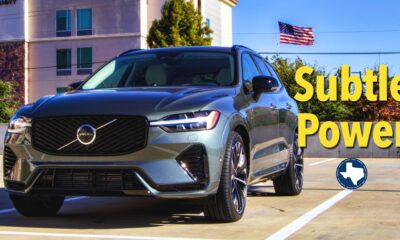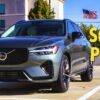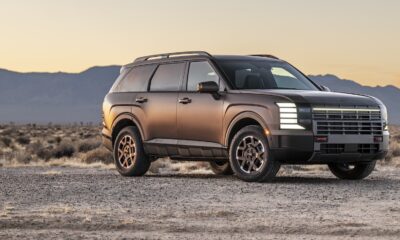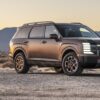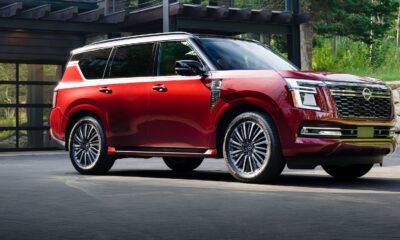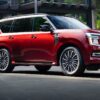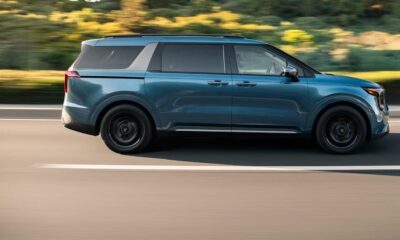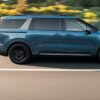Car Reviews
TOYOTA’S NEW SEQUOIA – IT’S A GAS
TOYOTA’S NEW SEQUOIA
IT’S A GAS
Comfortable, competent, and confident, the all-new 2025 Toyota Sequoia would be a fine choice for families needing to tow massive things even if it were not its niche’s reigning fuel economy champion.
The Sequoia competes in the $60,000 to $80,000 market with the Chevy Tahoe and Ford Expedition. All can haul half a soccer team plus a 30-foot travel trailer with water tanks down rocky and rutted roads. With 4WD all will easily maneuver a cabin cruiser up and down a slippery boat ramp.
The ability to do things like that a few times a year comes with monthly donations of $200 to $270 at the gas pumps.
The Sequoia, which used to be a horrid gas guzzler, is now only a bad one, thanks to a twin-turbo 3.5 L V6 with an electric motor bolted on the back. The hybrid pair accelerates like lightning uncoiling from a cloud, instant and fluid. Equally notable, it delivers an EPA-estimated 22 mpg. At least that is what the EPA says. In our week of driving we averaged 18.4 mpg. That is 50% better than what we saw in the previous generation Sequoia.
We tried to do better. Once, while returning through De Queen after a jaunt through the Ouachitas, we jumped off U.S. 71 and took Arkansas 41 south to New Boston. Lightly traveled, it is a peaceful, scenic run through the Little River bottoms. The wide-open spaces let us lock in at 60 mph and run long stretches at steady throttle. In those circumstances, the SUV managed 22.4 mpg.
As soon as we had a passing event, however, even short sorties into the throttle cause the V6’s twin turbos to suck down immense amounts of gas. We did not spend long in the passing lane, but even 15-20 seconds of a glorious burst of speed sends fuel economy plummeting. There is much to love about this big lug, but in seven days I spent more on gas with this vehicle than I usually do in three months, or that frugal blonde spends in half a year on her plug-in hybrid, which averages 84 mpg.
Toyota says the engine will run fine on regular unleaded, but the turbos run better with premium fuel. We tried both. A 20% increase in fuel cost produced a less than 10% increase in fuel economy.
I get that people love how they feel inside these massive vehicles. The sense of power and accomplishment they provide gratifies the ego. Still, suppose you do not need to drag around 4 ½ tons regularly. In that case, you can load your mob into an equally comfortable and safer (really, unibodies absorb crash energy, frames transmit it) Highlander Hybrid and cut $500 off the monthly note and another C-note off the fuel bill.
Waiting behind a line of empty pickups and SUVs to fill up at Sam’s Club, I wondered why people needlessly throw money at the oil companies every week. Perhaps it is gratitude for all the oil companies have done for them. More likely, as Will Rogers said, it is that some people can read, some can figure things out for themselves, and some must pee on the electric fence.
Muscular looks
The Sequoia adopts Toyota’s current truck aesthetic with a broad grille, squared fenders, and flush-mounted LED headlights. At 205.1 inches long, 80.8 inches wide, and 78.7 inches tall, the body sits higher than most family SUVs, yielding a commanding ride height. Substantial underbody shielding and sculpted side sills enhance airflow beneath the frame, while an available hands-free power liftgate and deployable running boards aid entry and loading.
Our 1794 model came with the running boards, which was a good thing. Without them, beautiful but diminutive Blonde Beauty needed a step ladder to climb into the monster. We learned this before I discovered the switch to turn on the running boards. Who would turn them off?
Compared with the Tahoe and Expedition, the Sequoia carries a more angular profile and a flatter roofline, which creates more third-row headroom but marginally increases drag. Its front fascia mirrors the Tundra’s design language, reinforcing Toyota’s truck lineage.
Optional 20-inch wheels and a TRD Sport grille insert distinguish higher trims without compromising approach angles. Functional upgrades over the previous generation include integrated roof rails rated for 300 lb of cargo and a standard rear stabilizer bar that improves high-speed stability.
People love the look of roof rails because they project an adventurous spirit but rarely use them. Remember that aerodynamic drag is the most potent variable in fuel economy, even more important than mass, which tends to stay in motion. Roof rails reduce fuel economy by an average 2%. Put something up there, and a vehicle uses 20% more fuel. What did he say? He said to look out for the electric fence.
Glorious interior
The 1794 Edition pairs full-grain leather seats—stamped with a cattle-brand motif—and open-pore wood trim. Its dashboard layout centers a 14-inch touchscreen above physical climate knobs and a row of metal-finish toggles, reducing menu dives. The second-row bench seating fits three adults, and a 60/40 split bench in the third row folds flat to yield up to 108 cubic feet of cargo space, roughly 4 more than the Expedition.
Critics commend the cabin’s expansive feel and sightlines that provide a sense of control. Consumer Reports praised the Sequoia for the interior’s high quality and materials and excellent fitment.
Built-in ambient lighting and an optional 14-speaker JBL audio system elevate the atmosphere without overstating luxury. Storage solutions include a deep center console bin, under-floor cargo drawers, and door pockets sized for large bottles. Front-seat heating and ventilation come standard on Limited and above; heated second-row captain’s chairs appear on Platinum, 1794, and Capstone. IP and knee bolster padding meet or exceed class norms, enhancing long-distance comfort.
Technologically advanced
Toyota’s infotainment software presents icons in a grid layout, allowing swipe gestures and voice commands for navigation, media, and climate. Startup responds within 1–2 seconds, but some reviewers found occasional lag when toggling split-screen modes.
Wireless Apple CarPlay and Android Auto arrive standard; built-in Amazon Alexa offers remote vehicle functions. Over-the-air updates download background data overnight, ensuring system currency.
Driver-assistance arrives via Toyota Safety Sense 2.5+, which bundles pre-collision with pedestrian detection, full-speed adaptive cruise control, lane-tracing assist, blind-spot monitoring and rear cross-traffic alert. An available surround-view camera and automatic parking assist add further safety.
The Sequoia holds a five-star NHTSA overall rating and an IIHS Top Safety Pick designation with optional LED projector headlights. Standard features include automatic emergency braking with cyclist detection, lane departure alert with steering assist, and an adaptive high-beam system. Optional equipment adds front and rear parking sonar, a driver-monitoring camera and reverse automatic braking. Consumer Reports awarded the Sequoia a high crash-avoidance score, noting the pedal-to-steering integration reduces collision risk.
Sweet driver
The i-Force Max hybrid powertrain yields 437 hp and 583 lb-ft of torque. The latter is the key metric. Rather than boost fuel economy, Toyota engineers use the hybrid gear to boost torque, the key to rapid acceleration and towing.
A 10-speed automatic channels torque to all wheels via a two-speed transfer case. On paved roads the Sequoia relaxes into its weight, absorbing imperfections without excessive pitch or dive. Steering feedback remains light at low speeds but firms up on highway ramps, instilling confidence.
Off-road, Multi-Terrain Select and Crawl Control help tailor power delivery across mud, sand, or rock. A 10.2-inch ground clearance and available locking rear differential help negotiate ruts and ledges.
Exhaust tuning gives the Sequoia a deep, muscular burble from its twin tailpipes. Under throttle, it rumbles like a powerful offshore cruiser slicing through open water with effortless authority.
Toyota had early issues with this drivetrain, and, to be honest, I wonder if it will live up to the manufacturer’s reputation for bullet-proof reliability, which may be simply my distrust of small-displacement, high-output internal combustion engines. I have driven three vehicles with this drivetrain, and all seemed to struggle under load, and all exhibited occasional rough shifts at low to moderate throttle. We will see. One thing we can be sure of is that Toyota will stand behind the product. The company is replacing 100,000 non-hybrid twin-turbo V6 truck engines because of manufacturing residue left in the crank cases.
By the numbers
The Sequoia SR5, with a starting point of $61,100, is a well-equipped base trim with essentials like an 8″ touchscreen and fabric seats, while the Limited at $70,100 adds comfort upgrades like ventilated front seats and a 14″ display. The Platinum, representing an investment of $75,200, brings luxury with leather, a panoramic sunroof, and JBL audio. The subject of this test, the 1794 Edition, costs $79,500 and adds Western-themed styling with wood accents. Finally, the Capstone takes almost all of $90,000, tops the range with premium touches like acoustic glass, semi-aniline leather, and a head-up display.
Bottom line
If you need something this big and beefy, the Sequoia is the best in class.





